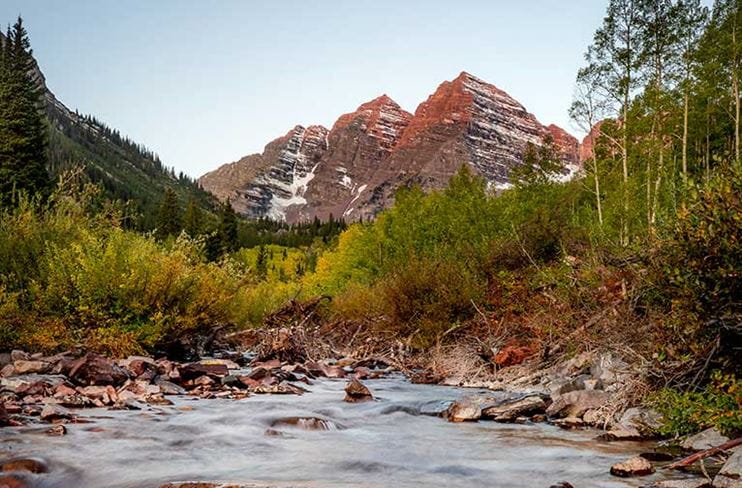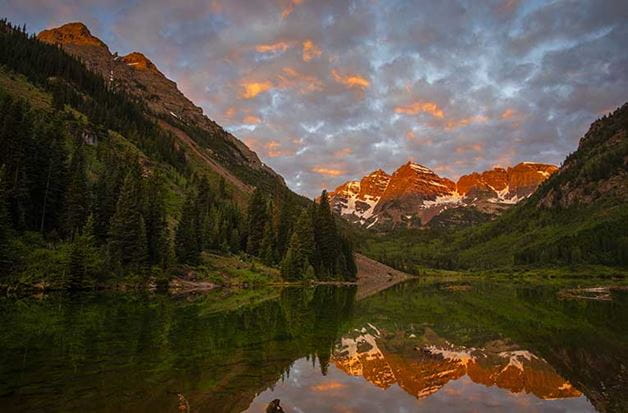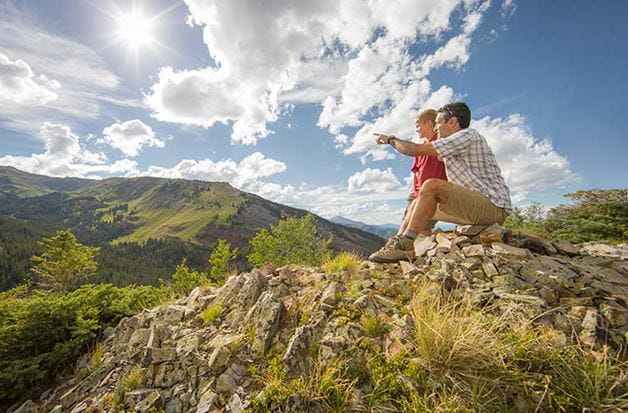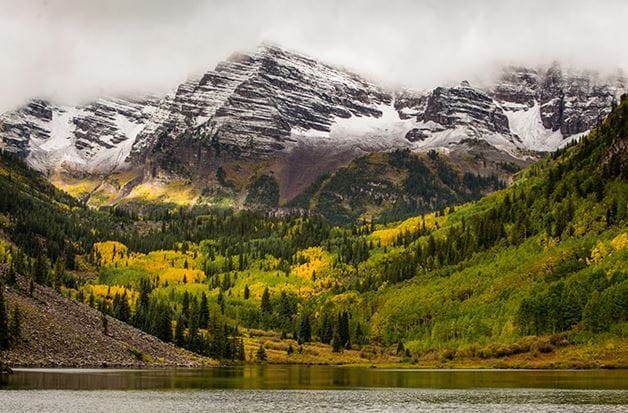
Aspen Hiking Guide

Know the trailhead, distance, and elevation gain of your hike ahead of time.
Hiking in the Aspen Snowmass area is world-renowned. Trails laden in wild flowers surrounded by the Elk Mountain range. Aspen groves. Tall, dense forests. High alpine lakes and small, hidden streams. Short day hikes and big backpacking trips. It’s all here to be discovered once you lace up your shoes and set out on a trail.
You can skip the climb and ride the gondola to explore the trails atop our mountains and beyond the resort, incredible hiking options abound in the adjacent National Forest areas. Get to know these areas via our guide below with routes broken down by trailhead location, distance, elevation gain, and beta to make the most of your adventure.
Tips & Tricks
Dogs
Dogs are welcome on most trails—and our gondolas too—but check leash laws for individual trails before embarking. Wildlife sightings, including moose and bear, are common in the area.
Weather
The weather changes rapidly in high-country Colorado. Even if it’s sunny when you leave, it could be storming when you’re reaching the summit. Pack layers, warm clothes, and always pack a rain jacket. At the first sign of lightning—even miles away—seek shelter and lower ground.
Altitude
Remember you’re at high altitude. Sunscreen and water are your friends. Pay attention to any symptoms of altitude sickness, such as headaches.
Bikes on the Trail
Bikers and hikers share the trail. Be courteous to one another.
Buttermilk & Aspen Highlands
You can hike on Buttermilk Ski Area and Aspen Highlands, too—but there won’t be a restaurant to greet you at the top.
Just In Case ...
If you get into trouble on Snowmass, call 970-923-0531.

Snowmass Hiking Trails
With the Elk Camp Gondola running all summer, Snowmass is the perfect place for quick-and-easy hikes or full days out with the whole family. Many trails are accessible via the Elk Camp area, where you can grab a coffee at Elk Camp Restaurant before the stroll, and return for lunch filled with locally sourced ingredients when you are done. Consider starting your day with a leisurely hike and then spend the afternoon enjoying the many activities at the Lost Forest.
Snowmass Village Nature Trail
Length: 0.7 miles roundtripElevation: Less than 100 feet
Trailhead: Snowmass Base Village
Extends through aspen forests where wild columbine—the Colorado state flower—can be seen.
Rabbit Run
Length: 0.7 miles roundtripElevation: 122 feet
Trailhead: Elk Camp mid-mountain
Weaves in and out of the subalpine forest where sharp-eyed hikers can spot a variety of birds and forest-dwelling wildflowers.
Elk Camp Nature Trail
Length: 1 mile roundtripElevation: Minimal
Trailhead: Elk Camp mid-mountain
A simple hike through the coniferous forests surrounding the Elk Camp area.
Sierra Club Loop
Length: 1.75 miles roundtripElevation: 533 feet
Trailhead: Elk Camp mid-mountain
This convenient loop trail climbs into a subalpine ecosystem and then returns to the Elk Camp area. Can be combined with the Elk Camp Summit Trail.
Rim Trail
Length: 7.6 miles one way (although shorter segments can be enjoyed)Elevation: 1,199 feet
Trailhead: Deerfield Dr., Snowmass Village
A more rigorous half-day hike can be enjoyed along this trail, which switchbacks up into the meadows above Snowmass Village to the north. Gorgeous views abound.
Tom Blake & Government Trail Loop
Length: 9.4 miles roundtripElevation: 1,905 feet
Trailhead: Snowmass Base Village
Criss-crossing Snowmass and winding its way through mixed woodlands and grassy meadows, the Tom Blake and Government Trails offer a fun way to experience the resort in summer.

Aspen Mountain Hiking Trails
Rising right from the heart of downtown Aspen, Aspen Mountain could not be an easier destination for half-day hikers. Take the Silver Queen Gondola to the top, stock up on snacks at the Sundeck, then navigate to any of the trails that fan out from atop the mountain.
Aspen Mountain Nature Trail
Length: 1 mile roundtripElevation: Minimal
Trailhead: Atop Aspen Mountain
This dog-friendly trail passes through small meadows and subalpine forest with views into the nearby Maroon Bells-Snowmass Wilderness.
Richmond Ridge Trail
Length: 2.2 miles one wayElevation: Minimal
Trailhead: Atop Aspen Mountain
Follows a wide dirt road along the ridge from the summit of Aspen Mountain. Boasts stunning views of the surrounding mountains.
Ajax Trail
Length: 1.5 miles one wayElevation: 400 feet
Trailhead: Near Koch Park
From the base of the mountain near Koch Park, this trail skirts the base of Aspen Mountain and takes in views of the town. This is a superb hike for early evening when it is a little more shaded.

Hiking Around the Roaring Fork Valley
Whether it is a long walk before dinner or a brisk climb over lunch break, Aspenites love to take to the abundance of half-day hikes in and around the town. Here are some of the top choices.
East of Aspen Trail
Length: 6.2 miles roundtrip (numerous shorter segments and access points)Elevation: Minimal
Trailhead: Stillwater Rd. & Hwy. 82 just east of town
This flat trail is unique to the valley, as it winds its way through aspens, willows and riparian habitat along the one of the Roaring Fork River’s only slow-flowing sections.
Rio Grande Trail
Length: 1 mile one way in town (numerous shorter segments and access points)Elevation: Minimal
Trailhead: Puppy Smith Road & the River
The most popular trail along the Roaring Fork River is the paved Rio Grande Trail, which continues all the way to Glenwood Springs down valley, 42 miles away. Note: this is a popular cycling path as well.
Smuggler Mountain Overlook
Length: 2.8 miles roundtripElevation: 800 feet
Trailhead: Off Smuggler Mountain Road
This short and steep hike along the dirty Smuggler Mountain Road leads to an expansive overlook of downtown Aspen and Aspen Mountain.
Ute Trail
Distance: 3.1 miles one wayElevation: 3,192 feet
Trailhead: Off Ute Ave.
This trail’s popularity stems from its eagle’s-eye views of downtown Aspen. Ascending the east flank of Aspen Mountain, the path passes iconic Ute Rock and eventually reaches the Sundeck at the summit. Reward yourself with a cold one at the top.
Hunter Creek
Length: 5 miles roundtripElevation: 960 feet
Trailhead: Hunter Creek Lane
The Hunter Creek Trail to Van Horn Park offers great views of the distant Elk Mountains. But best of all are the wildflowers in mid-summer.
Sunnyside Trail
Length: 10.8 miles roundtripElevation: 2,683 feet
Trailhead: Cemetery Lane
As the name of this trail suggests, Sunnyside stays on the southern face of Red Mountain for its entire length, offering numerous views of Aspen Mountain as well as wildflowers in June and July.

Maroon Bells-Snowmass Wilderness Area
This pristine and protected area stretches across 181,535 acres of montane, subalpine and alpine habitat. More than 100 miles of trails cover the terrain, including this marquee half-day hike.
Maroon Lake Scenic Trail
Length: 1 mile roundtripElevation: Minimal
Trailhead: Maroon-Snowmass Trailhead
This enormously popular trail follows the northern shore of Maroon Lake, taking in the iconic view that made the Maroon Bells world famous. Wildflower meadows and aspen groves surround the scene.
Crater Lake
Length: 4 miles roundtripElevation: 490 feet
Trailhead: Maroon-Snowmass Trailhead
If the Maroon Lake Scenic Trail (above) is not challenging enough, this climb through aspens and alpine boulder fields to Crater Lake is worth considering. The lake rests directly underneath the lofty summit of North Maroon Peak. Make a full day of it by exploring the nearby meadows.
Cathedral Lake
Length: 6 miles roundtripElevation: 1,980 feet
Trailhead: Cathedral Lake Trailhead
Another high alpine lake worth visiting near Ashcroft is Cathedral Lake. The lake is larger than nearby American Lake, and the trail offers a good balance between moderate and strenuous pitches.
American Lake
Length: 6.4 miles roundtripElevation: 1,990 feet
Trailhead: American Lake Trailhead
Hidden away in a high alpine valley above the ghost town of Ashcroft, American Lake is a favorite among locals, featuring many wildflower meadows in July and August.
Buckskin Pass
Length: 10 miles roundtripElevation: 2,877 feet
Trailhead: Maroon-Snowmass Trailhead
The climb to Buckskin Pass may be strenuous, but presents hikers with an unparalleled reward — perfect views of Pyramid Peak and the north face of North Maroon Peak. This trail climbs above treeline, so be sure to crest the pass by noon to avoid afternoon thunderstorms.
Snowmass Lake
Length: 15.5 miles roundtripElevation: 5,141 feet
Trailhead: Maroon-Snowmass Trailhead
One of Colorado’s very best wildflower hikes is a doozy to do in a day. After climbing Buckskin Pass (above), the trail descends through alpine meadows and forest to the large Snowmass Lake beneath 14,092-foot Snowmass Mountain.

Independence Pass Area
To the east of Aspen lies the twists and turns of Highway 82 as it climbs over Independence Pass. The area is filled with numerous trailheads, many leading deep into the wilderness. These two trails are much shorter and easily accessible.
Discovery Braille Trail
Length: 0.4 miles roundtripElevation: Minimal
Trailhead: Discover/Braille Day Use Area
Oriented on the visually impaired, the Discovery Trail includes braille signage and cord-based navigation for blind hikers. Located just off the highway between Aspen and Independence Pass.
The Grottos
Length: 1 mileElevation: Minimal
Trailhead: Grottos Trailhead
This short but dramatic trail gives hikers a glimpse of waterfalls, boulder gardens and strange rock formations along the Roaring Fork River. High runoff in spring can make sections of this trail — plus river access — dangerous.
Lost Man Loop
Length: 13 miles roundtripElevation: 2,500 feet
Trailhead: Lost Man Trailhead
Requiring a car shuttle, the Lost Man Loop climbs into the Hunter-Fryingpan Wilderness Area, visits two alpine lakes, crosses an alpine path, and connects two adjacent valleys.

Down Valley
Down valley from Aspen and Snowmass, you will find several trails that climb above the towns of Basalt and Carbondale and offer a different perspective on this slice of Colorado.
Mount Sopris
Length: 13 miles roundtripElevation: 4,412 feet
Trailhead: Thomas Lakes Trailhead
While Mount Sopris is not even close to being the tallest peak in the Elk Mountains, from the town of Carbondale it sure looks like it. This massive mountain’s 12,965-foot summit can be reached from a straightforward but challenging route.
What to do if you run into...
A Bear
Stay calm, back away slowly, and take an alternate route. Never approach a bear or feed it, as this can result in an attack—or a fine. If a bear charges you, make yourself big and fight back while protecting your neck and face.
A Moose
Stay calm and back away slowly, giving a minimum of 20 yards of personal space. Avoid getting between a mother and her offspring and never feed a moose. Warning signs for a moose preparing to attack include raised hair, stomping, and grunting. If you notice this behavior, it’s best to get behind a tree, a rock, a car, or anything that can separate you from the attacking animal. If struck by a moose, curl up and play dead.
A Mountain Lion
Do not crouch, hide, or run away. Instead, make yourself look big, make loud noises with your arms above your head, maintain eye contact, portray a dominant demeanor, and back away slowly. If a cougar lunges at you, protect your eyes, face, and neck while fighting back.






